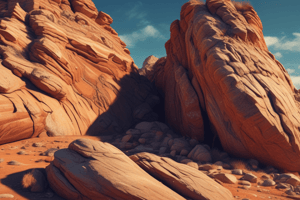Podcast
Questions and Answers
What do graded bedding, cross-bedding, ripple marks, and mud cracks provide clues about?
What do graded bedding, cross-bedding, ripple marks, and mud cracks provide clues about?
- The mineral composition of sedimentary rocks
- The environment where sedimentary rocks formed (correct)
- The age of sedimentary rocks
- The temperature at which sedimentary rocks formed
What do sedimentary rocks preserve a record of?
What do sedimentary rocks preserve a record of?
- History (correct)
- Climate change
- Volcanic activity
- Biological evolution
How are sedimentary rocks formed?
How are sedimentary rocks formed?
- By the compression and cementation of sediment grains (correct)
- By the metamorphism of existing rocks
- By the cooling and solidification of magma
- Through volcanic eruptions
What is the term used to describe the layering found in sedimentary rock?
What is the term used to describe the layering found in sedimentary rock?
What does stratification literally mean?
What does stratification literally mean?
What are sedimentary rocks comprised of?
What are sedimentary rocks comprised of?
How can a rock detective determine the origin of sedimentary rocks?
How can a rock detective determine the origin of sedimentary rocks?
What does cross-bedding in sedimentary rocks indicate?
What does cross-bedding in sedimentary rocks indicate?
What do ripple marks in sedimentary rocks suggest about the rock's origin?
What do ripple marks in sedimentary rocks suggest about the rock's origin?
What can mud cracks in sedimentary rocks indicate about the rock's origin?
What can mud cracks in sedimentary rocks indicate about the rock's origin?
What do rounded sediment grains in sedimentary rocks suggest about the sediment's transportation?
What do rounded sediment grains in sedimentary rocks suggest about the sediment's transportation?
What does graded bedding in sedimentary rocks indicate about the sediment deposit?
What does graded bedding in sedimentary rocks indicate about the sediment deposit?
What can the varying colors of layers in sedimentary rocks tell you about the rock?
What can the varying colors of layers in sedimentary rocks tell you about the rock?
What does the presence of ripple marks and mud cracks in sedimentary rocks indicate about the rock's environment?
What does the presence of ripple marks and mud cracks in sedimentary rocks indicate about the rock's environment?
What kind of sedimentary environment would likely produce cross-bedding and ripple marks in the rock?
What kind of sedimentary environment would likely produce cross-bedding and ripple marks in the rock?
What can the varying colors in sedimentary rock layers tell you?
What can the varying colors in sedimentary rock layers tell you?
What does the presence of rounded grains in sedimentary rock imply?
What does the presence of rounded grains in sedimentary rock imply?
What does graded bedding in sedimentary rocks indicate?
What does graded bedding in sedimentary rocks indicate?
What does cross-bedding in sedimentary rocks reveal about their origin?
What does cross-bedding in sedimentary rocks reveal about their origin?
What do ripple marks in sedimentary rocks indicate?
What do ripple marks in sedimentary rocks indicate?
What do mud cracks in sedimentary rocks suggest about their origin?
What do mud cracks in sedimentary rocks suggest about their origin?
What can the shape of different sediment grains provide clues about?
What can the shape of different sediment grains provide clues about?
What can the patterns by which sediments deposit reveal?
What can the patterns by which sediments deposit reveal?
Flashcards are hidden until you start studying



